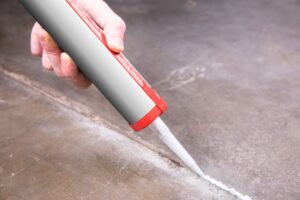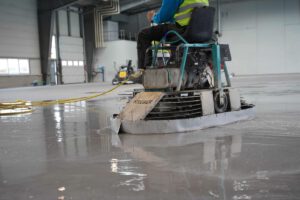Pouring concrete over concrete might be the perfect solution to fixing a worn-out slab or upgrading an old surface. After all, why go through the hassle of demolition when you can simply add a fresh layer? While it can be effective in the right circumstances, it is not always a foolproof solution. Poor preparation or unsuitable conditions can lead to cracks, instability, or wasted effort.
This article explores when pouring concrete over concrete works well and when it is better to start from scratch. If you are planning a project and unsure how to proceed, this guide will clarify, helping you make the best decision for a durable, lasting result.
Can You Pour Concrete Over Concrete?
Pouring concrete can be a practical solution to refresh an old surface without demolition, saving time and money. However, success depends on specific conditions. The existing slab’s stability, surface preparation, and intended use are vital in determining whether this approach is suitable. Let’s break down the scenarios where it works well and when it’s better to consider alternative options.

Conditions When You Can Pour Concrete Over Concrete
Pouring concrete over an existing slab can be effective if the base is structurally sound and free of significant cracks or instability. The surface must be cleaned thoroughly to remove dirt, grease, or debris that could prevent proper bonding. Additionally, applying a bonding agent or creating a roughened surface enhances adhesion between the layers. This method is ideal for addressing slight elevation changes, such as adding thickness to a concrete patio or leveling uneven areas. When done correctly under these conditions, it can provide a durable, long-lasting result without extensive groundwork.
Conditions When Pouring Concrete Over Concrete Isn’t Recommended
Pouring new concrete over an unstable or heavily cracked slab often leads to failure. If the original concrete shifts or deteriorates, it compromises the new layer’s integrity, causing premature cracks or uneven settling. Moisture issues, such as standing water or poor drainage, can weaken the bond and encourage long-term damage. Additionally, the new concrete may not adhere effectively if the existing surface is not prepared correctly, lacking a clean or textured finish. In these cases, removing the old slab and starting fresh is the best choice for a solid, reliable outcome.
Preparing the Old Concrete Surface for New Concrete

Proper preparation of the old concrete surface is crucial for ensuring the new layer adheres effectively and remains durable over time. The new concrete may crack, shift, or fail prematurely without this step. Critical preparation tasks include cleaning, inspecting, and repairing the existing slab to create a robust and stable foundation.
Surface Cleaning and Inspection
Thoroughly cleaning the surface removes dirt, grease, and debris that can prevent bonding. Power washing or scrubbing with a concrete cleaner ensures a clean base. Inspection is equally important to identify structural weaknesses, like deep cracks or uneven areas, that might compromise the new concrete’s performance.
Fixing Cracks and Imperfections
Repairing cracks and filling imperfections prevents underlying issues from transferring to the new layer. Use patching compounds or epoxy fillers to address visible damage. Smooth out uneven areas to create a level surface, ensuring the new concrete layer bonds effectively and achieves long-term stability.
How to Pour Concrete Over Concrete
Pouring concrete over an existing slab involves careful planning and execution to achieve a durable, professional finish. Each step, from mixing to curing, requires attention to detail. By following proper techniques, you can ensure the new layer bonds effectively and withstands the test of time. Let’s walk through the process.
Measuring and Mixing the Concrete
Accurate water and concrete mix measurement is essential for a consistent, workable mixture. Use a high-strength concrete mix suitable for overlay projects, and follow the manufacturer’s instructions. Proper mixing, whether done by hand or with a mixer, ensures the material has the correct texture for even application.
Pouring the Concrete
Begin by spreading the concrete evenly over the prepared surface. Use tools like a screed or trowel to smooth and level the layer. Work quickly to avoid premature setting, and ensure the thickness matches your project’s requirements. This step sets the foundation for a uniform, durable finish.
Finishing and Curing the Concrete
Finishing includes smoothing the surface with a trowel and adding texture if needed for traction. Proper curing is critical to prevent cracks and ensure strength. Keep the surface moist by covering it with plastic sheeting or spraying water periodically for several days, as your mix recommends.
Common Mistakes to Avoid When Pouring Concrete Over Concrete

While pouring concrete can save time and resources, avoiding common pitfalls is essential for a successful outcome. Mistakes such as inadequate preparation, poor layering, or rushing the curing process can compromise the project’s durability. Understanding these missteps will help ensure your efforts yield long-lasting results.
Skipping Surface Preparation
Failing to clean and prepare the old slab is a significant error that leads to poor adhesion and premature cracks. Dirt, grease, and debris act as barriers, preventing the new layer from bonding effectively. Always prioritize cleaning, inspection, and repairs to create a stable foundation for the overlay.
Incorrect Thickness of the New Layer
Pouring a too thin or uneven layer can result in structural weaknesses and cracking over time. A layer less than 2 inches thick may not provide adequate durability. Ensure consistent thickness across the surface, tailored to the specific demands of your project.
Neglecting Curing Time
Rushing the curing process weakens the concrete, reducing strength and possible surface damage. Proper curing involves keeping the surface moist and protected for the recommended duration. Skipping this step risks compromising the longevity of the newly poured layer.
How Long Will Concrete Over Concrete Last?
When done correctly, concrete poured over an existing slab can last 10-20 years or more, depending on factors like preparation, material quality, and usage. Proper surface preparation, crack repairs, and adherence to curing guidelines are critical in achieving this durability.
However, poor conditions, such as an unstable base or inadequate bonding, can significantly reduce lifespan. Regular maintenance, such as sealing and addressing minor cracks promptly, can help extend the overlay’s longevity and ensure it remains structurally sound.
Is Pouring Concrete Over Concrete Worth It?
Pouring concrete over an existing slab can be cost-effective and time-saving when the slab is stable and adequately prepared. It eliminates the need for demolition and provides a durable, refreshed surface for patios, driveways, or floors, making it a practical option for many projects.
However, it is not always the best choice. The new layer may fail prematurely if the base is cracked, unstable, or prone to moisture issues. Evaluating the condition of the old concrete and following proper installation practices are crucial to ensuring the investment is worthwhile.
Why It’s Important to Hire a Professional for Pouring Concrete
Hiring a concrete professional ensures the job is done right, from proper surface preparation to precise pouring and curing. Experts know how to assess the existing slab, use the correct materials, and address potential issues, ensuring a durable, long-lasting result.

DIY attempts often lead to costly mistakes, such as poor bonding, uneven layers, or inadequate curing. Professionals bring experience, specialized tools, and techniques to avoid these pitfalls, saving you time, money, and frustration while delivering a high-quality finish.
Conclusion
Pouring concrete over concrete can be a practical solution for revitalizing old surfaces, provided the existing slab is stable and adequately prepared. Understanding when this method works, preparing the surface, and avoiding common mistakes is essential for success. With proper planning and execution, this approach can save time and money while delivering a durable, refreshed result.
For the best outcome, consider consulting professionals who can assess your project’s unique needs and ensure the job is done right. Whether you are repairing a driveway, patio, or floor, the proper techniques and expertise will help you achieve long-lasting results. Get started today and see what options are best for your new concrete installation project!





